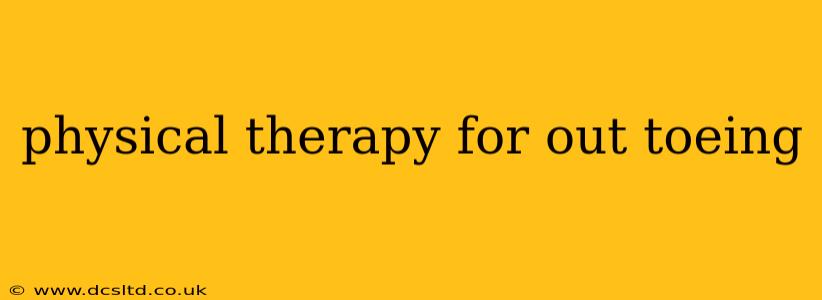Out-toeing, also known as external tibial torsion, is a condition where the feet point outward when walking. While often noticed in children, it can persist into adulthood, impacting gait and potentially causing discomfort or injury. Physical therapy plays a crucial role in addressing out-toeing, improving foot alignment, and promoting proper biomechanics. This comprehensive guide explores various physical therapy approaches used to correct out-toeing and improve overall lower limb function.
What Causes Out-Toeing?
Understanding the root cause of out-toeing is the first step towards effective treatment. Several factors can contribute:
- Developmental issues: In children, out-toeing can be a normal developmental variant, often resolving on its own as they grow. However, underlying conditions like metatarsus adductus (in-toeing at the midfoot) or internal tibial torsion (knees pointing inward) can influence foot placement.
- Bone structure: The shape and angle of the leg bones (tibia and fibula) can influence how the feet naturally align.
- Muscle imbalances: Tightness in certain muscles, particularly in the hips and legs, can pull the feet outwards.
- Past injuries: Previous injuries to the lower extremities, such as fractures or ligament damage, can affect foot alignment.
- Neuromuscular disorders: In some cases, neurological conditions can contribute to abnormal foot positioning.
What Physical Therapy Treatments are Used for Out-Toeing?
Physical therapy focuses on improving muscle strength, flexibility, and neuromuscular control to correct out-toeing and improve gait. Common treatments include:
Stretching Exercises:
- Hip and groin stretches: Tight hip muscles can contribute to out-toeing. Stretches like pigeon pose, butterfly stretch, and hip flexor stretches can improve hip mobility and flexibility.
- Hamstring stretches: Tight hamstrings can also influence foot positioning. Various hamstring stretches, including seated and standing variations, are beneficial.
- Calf stretches: Tight calf muscles can restrict ankle mobility and contribute to out-toeing. Gastrocnemius and soleus stretches are important.
Strengthening Exercises:
- Hip abductor and external rotator strengthening: Strengthening the muscles that stabilize the hips and rotate the legs outwards can help improve foot alignment. Exercises like clamshells, side-lying hip abduction, and external rotation exercises are crucial.
- Gluteal strengthening: Strong gluteal muscles are vital for proper hip and leg alignment. Exercises like bridges, glute bridges with band, and squats are highly beneficial.
- Ankle and foot strengthening: Strengthening the muscles surrounding the ankle and foot improves stability and control. Exercises include toe raises, alphabet writing with toes, and towel curls.
Manual Therapy:
Physical therapists might use manual techniques like soft tissue mobilization to release tension in tight muscles and improve joint mobility in the hips, knees, and ankles. This can help improve overall lower extremity alignment.
Gait Training:
Gait training focuses on improving walking patterns and correcting any compensatory movements associated with out-toeing. This can involve exercises to improve balance, coordination, and foot placement. The therapist may use visual cues, mirrors, or verbal feedback to guide the patient.
Orthotics:
In some cases, custom orthotics (shoe inserts) can help support the feet and improve alignment. Orthotics provide additional support and control, correcting abnormal foot mechanics.
How Effective is Physical Therapy for Out-Toeing?
The effectiveness of physical therapy for out-toeing depends on various factors, including the severity of the condition, the underlying cause, and the patient's adherence to the treatment plan. In many cases, physical therapy can significantly improve foot alignment, gait, and reduce any associated pain or discomfort. However, if the out-toeing is due to a significant bone deformity, surgery might be considered.
What are the Potential Complications of Untreated Out-Toeing?
Untreated out-toeing can lead to several complications:
- Increased risk of falls: Abnormal gait patterns increase the risk of falling, particularly in older adults.
- Joint pain: Improper foot alignment can strain the joints, leading to pain in the knees, hips, and back.
- Muscle imbalances: Persistent out-toeing can exacerbate existing muscle imbalances, potentially leading to further complications.
- Foot pain and discomfort: Out-toeing can place excessive stress on certain areas of the foot, causing pain and discomfort.
When Should I Seek Professional Help for Out-Toeing?
If you or your child experience persistent out-toeing, particularly if it is accompanied by pain, difficulty walking, or other symptoms, it is crucial to seek professional help from a physical therapist or physician. Early intervention can often prevent long-term complications and improve outcomes.
Can Out-Toeing Be Prevented?
While some causes of out-toeing are beyond our control, certain measures can help promote proper foot development and alignment:
- Regular physical activity: Encouraging physical activity, especially activities that promote proper balance and coordination, can contribute to healthy foot development.
- Proper footwear: Avoid shoes that restrict foot movement or cause abnormal foot positioning.
- Early intervention: Addressing any foot alignment issues early in childhood can often prevent long-term problems.
This information is for general knowledge and does not constitute medical advice. Always consult with a healthcare professional for diagnosis and treatment of any medical condition.
